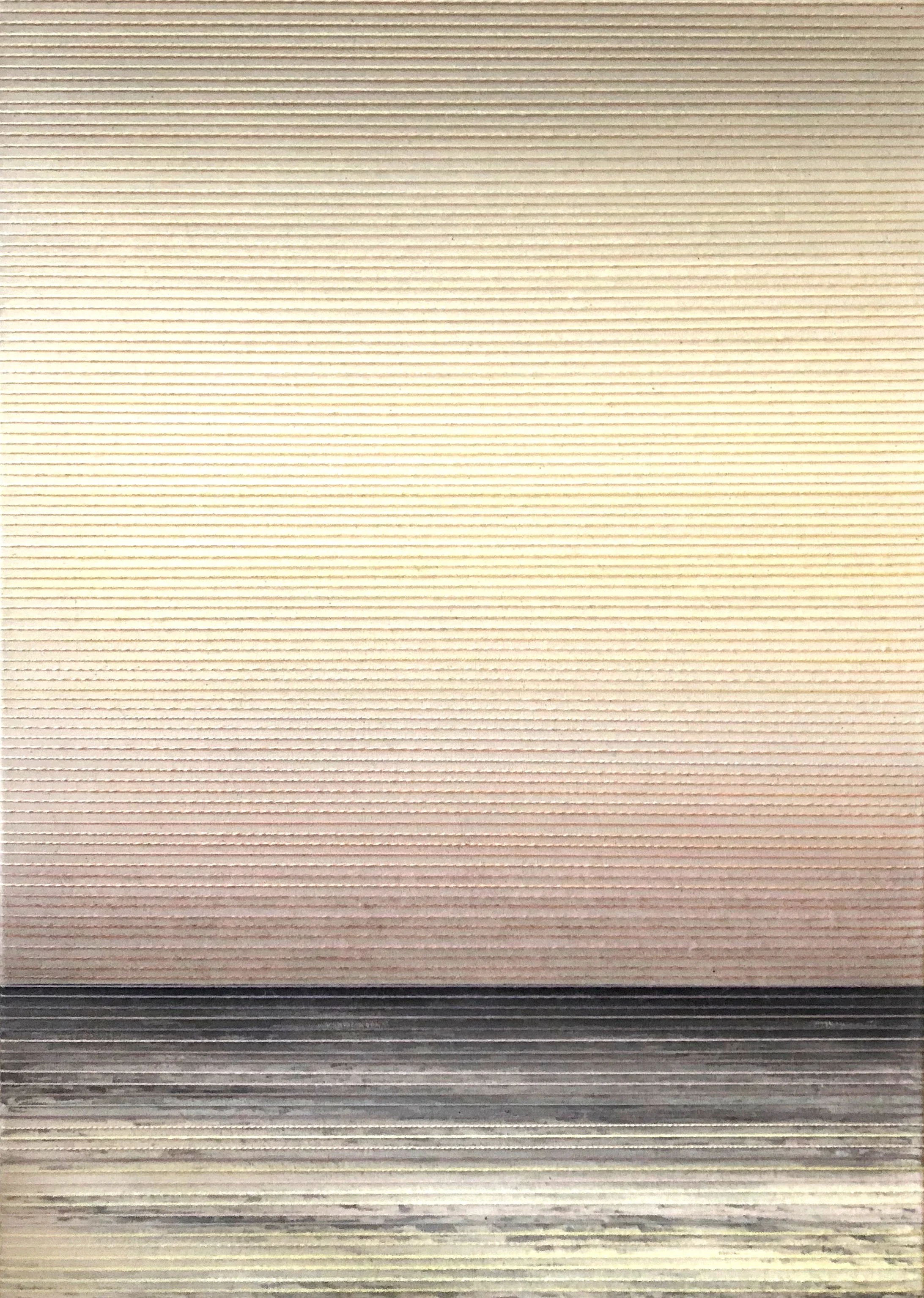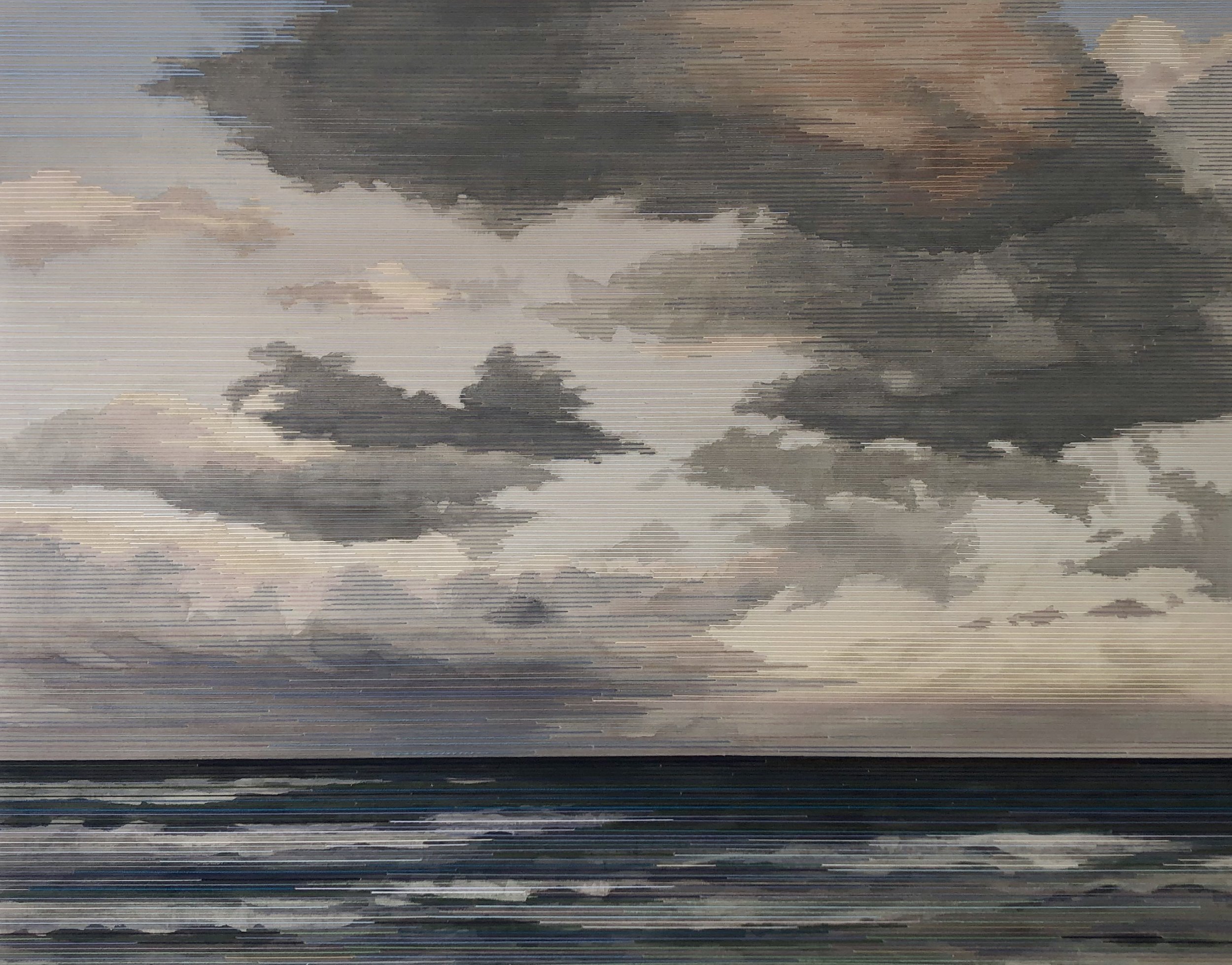
Mixed Media Works
Linda Maennel
Volume Two, Issue Two, “Senses,” Visual Art
Jaula d’oro, Ink / yarn on canvas, acrylic mirror glass, 70 x 60 cm, 2019.
For me, the sea is a symbol of my wanderlust and longing for freedom, silence, tranquility and vastness.
Erich Fried has described it very beautifully in his poem Sea:
When you come to the sea
one should begin to be silent
at the last blades of grass
one should lose the thread
and breathe in the salt foam
and breathe in the sharp hiss of the wind
and exhale
and breathe in again
When you hear the sand sawing
and the shuffling of the small stones
in long waves
you should stop wanting
And want nothing more, want only sea
Only sea
The viewer of my painting does not experience the sea directly, but through a kind of window opening. Out of a dark room, under a dramatic sky, one sees in the distance the vastness of the sea, which is like a promise.
The sea, painted in black ink on canvas and stitched over with horizontal lines of colored thread, is framed by a window arch made of gold-mirrored acrylic glass. Our longing for freedom, freedom to travel , vastness and distance is a very privileged one, considering the living conditions in other parts of the world.
I am aware that the sea is for many people on the other side of the ocean, a border that wants to be overcome at great risk to lead a better life on the other side.
Especially in the last year of the pandemic, my desire for vastness has become even greater, as life is forced to be more limited to the home environment and the wide world seems even more distant.
For this reason, I named the painting "Jaula d'oro," Spanish for "Golden Cage".
Fernweh, ink / yarn on canvas, 125 x 160 cm, 2021.
Tramuntana, ink/yarn on canvas, 27 x 20 cm, 2018.
Beyond the Tulum Skies, ink/yarn on canvas, 120 x120 cm, 2017.
Yucatan, ink / yarn on canvas, 210 x 130 cm, 2017.
In 2017, I was fortunate to have been invited to an artist in residence stay in Mexico. The AIR site is located in the middle of the jungle in Tulum, a retort town on the Yucatan Peninsula, on the site of the ancient Mayan site of Zama.
Over the past decade, the city has expanded considerably into the jungle, with a majority of the new residents being North Americans and Europeans who live a luxurious lifestyle there.
The original Mayan population, like the jungle, is being displaced and used for unskilled labor at some point. Thus, in the well-styled eco-chic of the restaurants, hotels and residences, one encounters Indians who are employed solely to clear the paths of creepers that have grown overnight.
It is a hopeless battle, as nature is overpowering there and the lush vegetation, as well as the climate with its ever more frequent hurricanes, will one day reabsorb the place.
If the plants that have proliferated overnight are seen by the new natives as invaders, on closer inspection it is the people of Western culture whose actions and supposed values are doomed to fail in this place.
This experience has kept me very busy and impressed me. Relatively quickly it was clear that a picture with which I wanted to capture this realization could not be limited to the rectangle of a canvas.
Thus, the ends of the yarn with which I colored the picture, painted in black ink on canvas, sprawl out of the
canvas and pour over the surface of the picture, creeping into the space in front of the painting and becoming an installation.
The dark frown of a faraway storm, the setting sun easing into an embroidered light, resisting its own fixed mechanism of the frame. Maennel’s seascapes and landscapes let the viewer settle into the feeling of distance. Yet, the embroidered trompe l’oeil maintains the illusion that we can actually sense the atmosphere in her scenes, more intimately than a completely two-dimensional image.
Certain threads of yarn, which delicately illuminate the gloaming hour, insist on the sensation of the air’s changeability; a warm thickness as the light subdues, the clearer air as the dark closes in. This texture also evokes the complex movements of the sunset itself; the scattering of wavelengths that eventually reaches our eyes, which have varying sensitivities, and the molecules of air that enter our lungs. The artist notes, in fact, being inspired by Erich Fried’s poem “Sea”, which embraces the act of arriving at a quiet seascape and breathing it in.
Like memories, Maennel’s embroidered paintings heighten the texture of a familiar, tangible experience. They are ready to dissolve or move on from their frames, enacting in a sense what Paul Klee has described as a fixated movement.
Yet, just as present in Maennel’s sea portraits is the tension of subjectivity. If these views evoke calm, deep breaths for some, they also might ask, as Christina Sharpe does in In the Wake, who gets to breathe in the freedom of clean air, and from what shore? For some, the sea’s “refrain” or loss “is upon us”, as the poet ‘Gbenga Adeoba writes in “Seafarers”. Migrants may discover the sea’s “unfulfilled promises”. Residents of low-lying islands may remark, in the same shared sunset, the sea’s encroachment on the shore due to climate change.
Then, in her work “Jungle,” Maennel breaks the constraints of the canvas: green yarn overgrows its space on the wall and spills onto the floor. Inspired by a residency in Tulum, Mexico, Maennel recreated the persistent vitality of the jungle; its evolutionary impetus to recreate itself, and its potential survival beyond those who destroy it.
Perhaps what unites Maennel’s work is the sense of surprise or revelation in realizing the yarn’s effect. It heightens the instinct to want to touch it, which is a way of bringing the sensations of seascapes, landscapes, and atmospheres to an intimate, interior space.
- The Editors
Notes to my work
My works are painted in black ink on canvas. They are more figurative paintings, often showing landscape scenes. To bring color into the scenery, but also to create a second, more abstract level, I embroider over the painting with colored thread. I embroider without exception in horizontal lines, which have about 5 mm distance from each other. This rasterizes the image and gives it something blurred. At the same time, the decent colors of the yarns colorize the painting.
Standing directly in front of the picture, it seems as if the layers dissolve. The eye merges painting and embroidery, it is hard to believe that the color is not part of the painting, but was embroidered on afterwards. I have observed at pretty much every exhibition that visitors can't stop themselves and secretly touch the painting, pushing the threads gently apart to discover the secret of how it was made. I also observe that there is a very great desire on the part of the viewers to touch the soft wool.
Presumably, the material is associated more with a certain cuddle factor, since wool is normally used in clothing or everyday objects such as blankets, pillows, etc...
Of course, it is not allowed and it excites me, to play with these aspects.

Glowing (II), ink/yarn on canvas, 52 x 40 cm, 2018

Glowing (V) , ink / yarn on canvas, 70 x 50 cm, 2020

Glowing (VI) , ink / yarn on canvas, 70 x 50 cm, 2020
C V
1983 born in Hausham, Germany
2003-2005: Studies of free painting,
Academy of Fine Arts Nuremberg, class of Diet Sayler
2005-2009: Studies of free art,
Academy of Fine Arts Nuremberg, class of Eva von Platen
2009: Awarded the title of Meisterschüler (master student)
and completed her studies
Move into a studio at AEG, Nuremberg
2014/15: artist in residence/ a room that...
Baumwollspinnerei Leipzig
2017: artist in residence/
Arthouse Tulum, Mexico
2021: Founding of Tillystudios, Nuremberg
Yucatan, ink / yarn on canvas, 210 x 130 cm, 2017.






